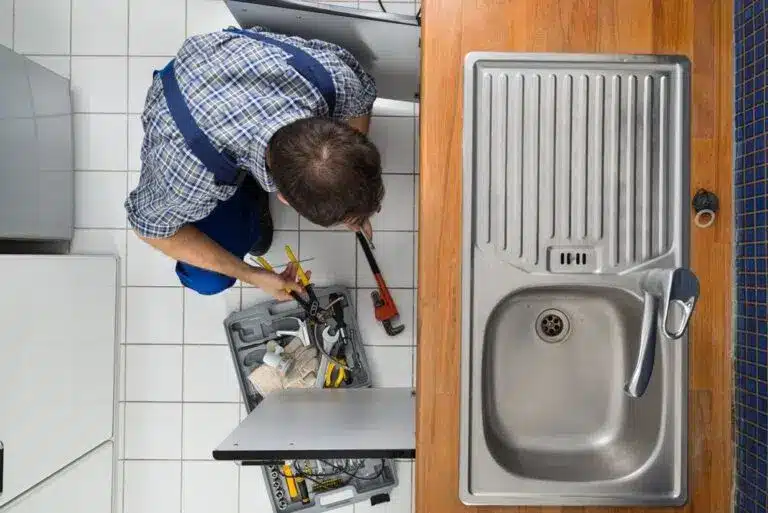What're your insights and beliefs about Why Is ?

Garbage disposals are important kitchen area appliances that help in dealing with food waste efficiently. Nevertheless, a dripping waste disposal unit can be an aggravating and messy issue to deal with. The good news is, numerous leakages can be taken care of quickly with a couple of easy steps. In this post, we will discuss how to take care of a leaking waste disposal unit successfully.
Introduction
Waste disposal unit are mounted under kitchen area sinks and are designed to shred food waste right into smaller pieces, allowing it to go through the plumbing system quickly. While these tools are typically reliable, leaks can take place over time because of damage, loosened connections, or damage to the device.
Step-by-Step Guide to Dealing With a Leaking Waste Disposal Unit
Turn Off the Power
Before attempting any kind of fixings, ensure that the power to the waste disposal unit system is switched off to avoid the danger of electric shock.
Find the Leak
Recognize the precise area of the leak and establish the reason
Tighten Connections
Make use of a wrench to tighten any type of loosened connections between the disposal unit and the plumbing system.
Change Seals or Gaskets
If the leak is because of worn seals or gaskets, get rid of the old elements and change them with new ones.
Patching Fractures or Holes
For splits or openings in the disposal system, use epoxy or an ideal patching material to secure the broken area.
Recognizing the Source of the Leak
Prior to attempting to repair a leaking waste disposal unit, it is essential to recognize the source of the leak. This can generally be done through aesthetic assessment or by carrying out basic examinations.
Visual Examination
Inspect the garbage disposal unit carefully for any type of indicators of water leakage. Pay very close attention to areas around seals, gaskets, and link points.
Testing for Leakages
One way to test for leakages is by running water with the disposal system and looking for any kind of visible indications of leakage.
Usual Causes of Leaks in Waste Disposals
Worn Seals and Gaskets
Seals and gaskets play an important function in preventing water from leaking out of the garbage disposal. In time, these elements can weaken, resulting in leakages around the disposal device.
Loose Links
The links between the waste disposal unit and the pipes system can become loosened over time, triggering water to leakage out throughout operation.
Splits or Holes in the Disposal Device
Physical damage to the waste disposal unit, such as splits or holes in the real estate, can also result in leaks.
Devices and Products Needed for Fixing a Leaking Garbage Disposal
Before beginning the repair service procedure, gather the needed tools and materials, consisting of a screwdriver, flexible wrench, plumber's putty, replacement seals or gaskets, and epoxy or patching product for fixing cracks or holes.
Examining the Waste Disposal Unit After Repair
When the repair work is full, test the waste disposal unit by running water through it to ensure that the leak has been dealt with.
Preventive Maintenance Tips to Prevent Future Leaks
To avoid future leaks, it is essential to perform normal upkeep on your waste disposal unit. This includes keeping it clean, staying clear of placing non-food products or difficult objects down the disposal, and occasionally looking for leaks or various other issues.
Verdict
In conclusion, repairing a leaking garbage disposal is a fairly uncomplicated procedure that can be finished with standard tools and products. By following the steps described in this write-up and practicing preventive upkeep, you can maintain your garbage disposal in good working problem and prevent costly repairs in the future.
HOW TO REPAIR A LEAKING GARBAGE DISPOSAL
The first thing to do if your garbage disposal starts to leak or exhibits other symptoms of wear and tear is to inspect the appliance quickly. Before making any repairs, check for any obvious cracks or damaged parts and turn the disposal off at the power source. Once you have located the issue, several tools might assist you in solving it. Many resources are available to assist you in putting your disposal back in working order, whether by purchasing new parts or professional assistance from a repair technician. So immediately act if you need help with leaky garbage disposal. You can rapidly resolve the problem and enjoy smoothly functioning appliances with thorough troubleshooting and help from web resources.
Food waste is disposed of using a garbage disposal system, which grinds and flushes it down the toilet. A garbage disposal is a motorized device with one or more rotating blades that grinds up food waste into little bits. They are commonly found under the kitchen sink. A dishwasher inlet or connector is often built into garbage disposals, allowing extra water to drain into the sink’s dishwasher. Several things, such as clogs, worn-out components, or damage to the inside walls of the unit, can bring on garbage disposal leaks or other problems.
WHAT ARE SOME COMMON PROBLEMS WITH GARBAGE DISPOSALS?
Jamming: One of the most frequent issues with garbage disposals is jamming. It occurs when hard or fibrous materials, such as bones, potato peels, or fruit pits, get stuck in the disposal’s blades or impeller. It can prevent the unit from operating correctly or cause it to make unusual noises. Clogging: If too much food waste or non-food items are put into the disposal at once, it can lead to clogging. Clogged disposal may result in slow drainage or a complete backup of water in the sink. Grease and fats can also solidify inside the disposal and contribute to clogging. Leaks: Garbage disposals can develop leaks over time. The most common areas for leaks are the sink flange, the discharge pipe connections, or the dishwasher connection. Leaks can cause water damage and need to be addressed promptly. Foul odors: Food residue can build up in disposal over time and cause unpleasant odors. Bacteria and mold growth inside the unit can also contribute to foul smells. Dull blades: The grinding blades in the disposal can become dull over time, resulting in inefficient chopping and grinding of food waste. That may lead to more frequent jams and increased strain on the motor. HOW CAN YOU TELL IF YOUR GARBAGE DISPOSAL IS LEAKING?
Visible water: Check underneath the sink where the garbage disposal is installed. If you notice water pooling or dripping around the unit or any adjacent pipes, it’s a clear sign of a leak. Musty odor: A persistent or moldy smell from your kitchen sink area could indicate a hidden leak. The moisture from a leaking garbage disposal can create a damp environment that promotes mold and mildew growth. Water damage: Examine the area surrounding the garbage disposal for any signs of water damage. Look for water stains, discoloration, or warping on the cabinet floor or walls beneath the sink. Decreased performance: A leak in the garbage disposal can affect its functionality. If you notice that the disposal is not grinding food waste properly or is making unusual noises, it could be due to water damage or a leak compromising its mechanisms. Rust or corrosion: Inspect the garbage disposal for any signs of rust or corrosion. A leaking unit can cause metal components to deteriorate over time. Look for rust-colored stains or deterioration on the disposal unit or surrounding pipes. https://theappliancepeople.com/how-to-repair-a-leaking-garbage-disposal/

Do you like reading up on Garbage Disposal Leaking From Bottom? Try leaving feedback below. We'd be glad to know your views about this post. In hopes to see you back again in the future. I beg you take the time to distribute this post if you appreciated it. Thanks for taking the time to read it.
Free Quote
 Bug Hall Then & Now!
Bug Hall Then & Now! Jurnee Smollett Then & Now!
Jurnee Smollett Then & Now! Lacey Chabert Then & Now!
Lacey Chabert Then & Now! Sarah Michelle Gellar Then & Now!
Sarah Michelle Gellar Then & Now! Ryan Phillippe Then & Now!
Ryan Phillippe Then & Now!